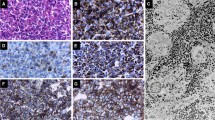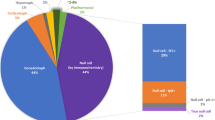Summary
A pituitary adenoma was transsphenoidally removed from a 4.5-year-old girl suffering from gigantism. Prior to the operation both the growth hormone (GH) and the prolactin (PRL) levels in the serum were elevated. By light microscopy the tumor appeared to be an acidophilic adenoma. Two distinct cell types, the densely granulated and the sparsely granulated cells, could be distinguished by electron microscopy. Double immunolabeling revealed the presence of GH alone in some densely granulated cells and PRL alone in some sparsely granulated cells, as well as GH and PRL co-localized in both of the morphologically distinguished cell types. Both cell types were identified in the monolayer and the suspension cultures by electron microscopy. GH and PRL concentrations in the culture media were measured by radioimmunoassay. The basal secretion of growth hormone was almost uniform during the 3-week cell culture period. GH and PRL release was significantly inhibited by bromocriptine. Our studies revealed a bimorphous and bihormonal mixed adenoma in childhood.
Similar content being viewed by others
References
Adams EF, Brajkovich IE, Mashiter K (1979) Hormone secretion by dispersed cell cultures of human pituitary adenomas: effects of theophyline, thyrotropin-releasing hormone, somatostatin, and 2-bromo-α-ergocryptine. J Clin Endocrinol Metab 49:120–126
Bendayan M (1982) Double immunocytochemical labeling applying the protein A-gold technique. J Histochem Cytochem 30:81–85
Blumberg DL, Sklar CA, David R, Rothenberg S, Bell J (1989) Acromegaly in an infant. Pediatrics 83:998–1002
Esiri MM, Adams CBT, Burke C, Underdown R (1983) Pituitary adenomas: immunohistology and ultrastructural analysis of 118 tumors. Acta Neuropathol (Berl) 62:1–14
Espiner EA, Carter TAH, Abbott GD, Wrightson P (1981) Pituitary gigantism in a 31-month-old girl: endocrine studies and successful response to hypophysectomy. J Endocrinol Invest 4:445–450
Favre L, Rogers LM, Cobb CA, Rabin D (1979) Gigantism associated with a pituitary tumor secreting growth hormone and prolactin and cured by transsphenoidal hypophysectomy. Acta Endocrinol 91:193–200
Fazekas I, Gyévai A, Bácsy E, Rappay Gy (1980) Rat intermediate lobe cell groups in suspension culture: morphological and functional characteristic. Acta Biol Acad Sci Hung 31:69–80
Felix IA, Horvath E, Kovacs K, Smyth HS, Killinger DW, Vale J (1986) Mammosomatotroph adenoma of the pituitary associated with gigantism and hyperprolactinemia. A morphological study including immunoelectron microscopy. Acta Neuropathol (Berl) 71:76–82
Gazsó L, Pásztor E (1980) Growth characteristics of human pituitary adenomas in tissue and cell cultures. Acta Neuropathol (Berl) 49:225–230
Gazsó L, Bácsy E, Pásztor E (1982) Light- and electron-microscopic features on an endocrinologically active pituitary adenoma cultured in vitro. Acta Neuropathol (Berl) 56:245–249
Guyda H, Robert F, Colle E, Hardy J (1973) Histologic, ultrastructural and hormonal characterization of a pituitary tumor secreting both hGH and prolactin. J Clin Endocrinol Metab 36:531–547
Halmi NS (1982) Occurrence of both growth hormone- and prolactin-immunoreactive material in the cells of human somatotropic pituitary adenomas containing mammotropic elements. Virchows Arch [A] 398:19–31
Horvath E, Scheithauer BW, Kovacs K (1987) Morphologic aspects of growth hormone-producing pituitary adenomas with emphasis on novel concepts. In: Lüdecke DK, Tolis G (eds) Growth hormone, growth factors, and acromegaly. Raven Press, New York, pp 107–114
Ishikawa H, Nogami H, Kamio M, Suzuki T (1983) Single secretory granules contain both GH and prolactin in pituitary mixed type of adenoma. Virchows Arch [A] 399:221–226
Kanie N, Kageyama N, Kuwayama A, Nakane T, Watanabe M, Kawaoi A (1983) Pituitary adenoma in acromegalic patients: an immunohistochemical and endocrinological study with special reference to prolactin-secreting adenoma. J Clin Endocrinol Metab 57:1093–1101
Kohler PO, Bridson WE, Rayford PL, Kohler SE (1969) Hormone production by human pituitary adenomas in culture. Metabolism 18:782–788
Koos WT, Miller MH (1971) Intracranial tumors of infants and children. Stuttgart: Georg Thieme Verlag, St. Luis. CV Mosby Co, pp 213–220
Kovacs K, Horvath E (1982) Pathology of pituitary adenomas. In: Givens JR (ed) Hormone-secreting pituitary tumors. Year Book, Chicago, pp 97–119
Kovacs K, Horvath E (1986) Pathology of growth hormone-producing tumors of the human pituitary. Semin Diagn Pathol 3:18–33
Laws ER, Scheithauer BW, Groover RV (1987) Pituitary adenomas in childhood and adolescence. Prog Exp Tumor Res 30:359–361
Lipson LG, Beitins IZ, Kornblith PD, McArthur JW, Friesen HG, Kliman B, Kjellberg RN (1978) Tissue culture studies on human pituitary tumours: radioimmunoassayable anterior pituitary hormones in the culture medium. Acta Endocrinol 88:239–249
Lloyd RV, Gikas PW, Chandler WF (1983) Prolactin and growth hormone-producing pituitary adenomas. An immunohistochemical and ultrastructural study. Am J Surg Pathol 7:251–260
Maira G, Anile C (1990) Pituitary adenomas in childhood and adolescence. Can J Neurol Sci 17:83–87
Mashiter K, Adams E, Beard M, Holley A (1977) Bromocriptine inhibits prolactin and growth-hormone release by human pituitary tumours in culture. Lancet 2 (8030):197–198
Prysor-Jones RA, Kennedy SJ, O'Sullivan JP, Jenkins JS (1981) Effect of bromocriptine, somatostatin, and oestradiol-17 on hormone secretion and ultrastructure of human pituitary tumours in vitro. Acta Endocrinol 98:14–23
Richmond IL, Wilson CB (1978) Pituitary adenomas in childhood and adolescence. J Neurosurg 49:163–168
Snyder J, Hymer WC, Wilfinger WW (1978) Culture of human pituitary prolactin and growth hormone cells. Cell Tissue Res 191:379–388
Trouillas J, Girod C, Lhéritier M, Claustrat B, Dubois MP (1980) Morphological and biochemical relationships in 31 human pituitary adenomas with acromegaly. Virchows Arch [A] 389:127–142
Zampieri P, Scanarini M, Sicolo N, Andrioli G, Mingrino S (1983) The acromegaly-gigantism syndrome: report of four cases treated surgically. Surg Neurol 20:498–503
Zurschmiede C, Landolt AM (1987) Distribution of growth hormone and prolactin in secretory granules of the normal and neoplastic human adenohypophysis. Virchows Arch [B] 53:308–315
Author information
Authors and Affiliations
Rights and permissions
About this article
Cite this article
Fazekas, I., Pásztor, E., Slowik, F. et al. Pathological and experimental investigations in a case of gigantism. Acta Neuropathol 85, 167–174 (1993). https://doi.org/10.1007/BF00227764
Received:
Revised:
Accepted:
Issue Date:
DOI: https://doi.org/10.1007/BF00227764




